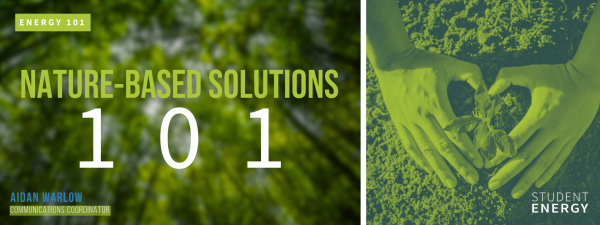Energy 101: Nature-based Solutions
Welcome to Energy 101! In this series, we bring you nuanced and concise perspectives on significant energy and climate topics around the world. Today, we are featuring the topic of Nature-based Solutions! Now, let’s feel the earth between our fingers and dig in…
Nature-based Solutions and Earth Month
April is Earth Month, a time to pay special attention to the constantly evolving needs of our planet, and to reflect on how human activity is irrevocably altering the Earth’s natural systems. Considering the always-increasing awareness of human intervention in nature, nature-based solutions (NbS) are poised to become a dominant topic in the global energy discussion as at-risk communities continue to struggle with the worsening effects of climate change.
It’s important that we understand how major polluters and other interested groups can take advantage of the language of NbS through ‘greenwashing’. This term refers to the use of the aesthetics, language, or trends of nature-based solutions, and its associated positive reputation, to promote projects that lack transparency, or could even have direct negative effects on local communities.
Let’s dive in!
In this post, we’ll introduce you to Nature-based Solutions as defined by the International Union for Conservation of Nature, the world’s foremost voice on NbS, explain why human rights are an essential component of the NbS philosophy, and finally study a very negative case of what can go wrong when “greenwashing” goes too far.
What are Nature-based Solutions?
The International Union for the Conservation of Nature (IUCN) defines a Nature-based Solution as:
Nature-based Solutions address societal challenges through actions to protect, sustainably manage, and restore natural and modified ecosystems, benefiting people and nature at the same time.
They target major challenges like climate change, disaster risk reduction, food and water security, biodiversity loss and human health, and are critical to sustainable development.
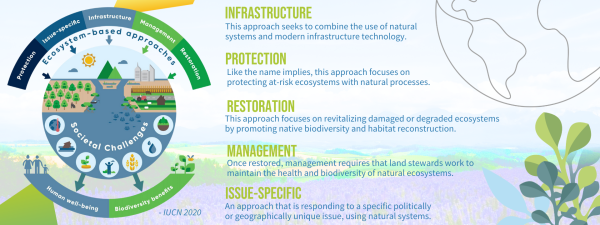
The IUCN outlines five major approaches to Nature-based Solutions: Protection, Restoration, Management, Infrastructure, and Issue-Specific NbS. Earlier in April, we shared a summary of each of these types of projects with a relevant case study example from the Nature-based Solutions Initiative’s NbS Case Study platform. Check out the post here and get to know the different forms a NbS project can take!
You may find that there seems to be a lot of overlap between the various approaches – this is true! An ecosystem restoration project will undoubtedly transition into a management or protection project at some point in its life-cycle. In addition, nature-based solutions are often lauded for their versatility, a core component of the NbS philosophy. In order to be a true Nature-based Solution, according to the IUCN’s “Global Standard for Nature-based Solutions,” a project must benefit the socio-economic wellbeing of local communities as well as the natural environment. Here’s why…
Rooted in Human Rights
In a recent blog article for the IUCN, International Law and Human Rights Expert Dr. Sener Dalyan outlines the importance of a human rights-centred approach to NbS. As part of this process, Dalyan explores the IUCN Global Standard’s 8 criteria which “provides a robust framework for designing, implementing, evaluating, adapting and improving NbS.”
Five of the eight criteria is directly related to human rights, as well as over half of the Standard’s 28 indicators used to gauge the success and sustainability of Nbs. We have collected a summary of each criteria below so you can form a quick idea of what should be required of any NbS project. All of this to say that human rights are an essential component of what makes a project a true NbS.
“Criterion 5 requires NbS to be based on inclusive, transparent, and empowering governance processes. It is only through such a process that the concerns of a wide range of stakeholders, in particular rights holders, can be heard and addressed. A well-functioning feedback and grievance mechanism with robust rules and procedures is an important means in ensuring that NbS provides expected human well-being and biodiversity benefits, and the rights are respected.” Dr. Sener Dalyan, 2024
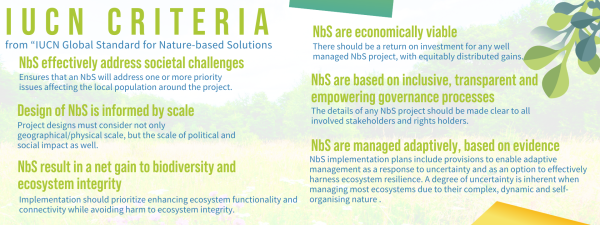
Now that we know what it takes to build a successful nature-based solution, what does it look like when a nature-based solutions project does not centre the needs and rights of local human populations?
Greenwashing and “Blood Carbon”
In late 2023, CounterPunch reporter Alexandria Shaner published an article titled “Blood Carbon: Kenyans are Being Erased so the UAE can Greenwash.” She begins by drawing a comparison between the historically well-publicized phenomenon of “blood diamonds” or “conflict diamonds.” The metaphor is apt and striking!
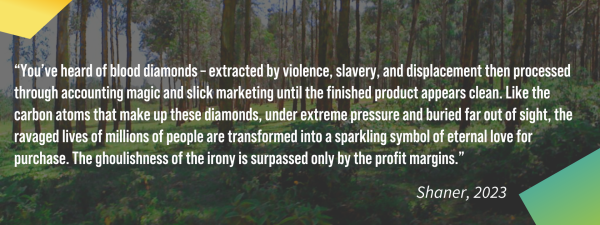
Shaner understands that this process is occurring anew as an unintended consequence of the rapidly expanding Carbon Market. Through the Carbon Market, governments and corporations are incentivized to engage in carbon capture, removal, and sequestration projects with the reward of huge profits and positive PR for acting “sustainably.” The ongoing eviction and expulsion of Indigenous Kenyan’s from their country’s forests is a clear example of how chasing carbon metrics for profit, without considering the impact on human rights, can have disastrous consequences.
In summary, the government of the United Arab Emirates (a global petrostate) recently invested over $450 million USD with the help of a US consultancy firm, into African emissions mitigation projects. By investing in carbon projects like these, the UAE is able to “greenwash” the negative effects of its massive investment in crude oil. “Greenwashing” is a well-discussed term referring to the use of creative accounting and marketing techniques to obscure the negative ecological impacts of a certain corporation, organization, or government by over-amplifying the positive effects of various eco-investments that a group may be involved in. Many of the IUCN’s criteria for NbS are designed to make sure this doesn’t happen!
One stipulation of the UAE’s deal with Kenya’s government is a reduction of emissions from the country’s forested areas. As a result, Kenya’s President Ruto ordered the mass eviction of tens of thousands of Indigenous Kenyans from these regions thinking it could protect their forests from encroachment.
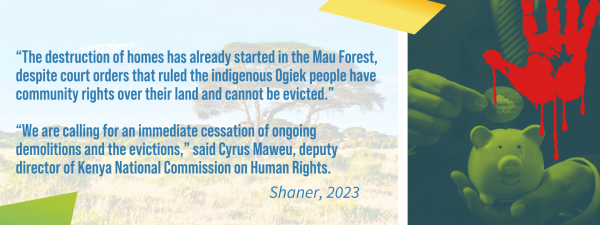
Shaner also points out that several of the organizations behind these types of projects, like the UAE-based Blue Carbon, are often run by people with connections to the government or the oil industry who lack vital experience in managing ecosystem projects and exhibit little genuine interest in protecting local ecosystems and consulting with local communities where these projects will take place. The treatment of Indigenous Kenyans at the behest of UAE petrocorps, in the name of “sustainability” should keenly illustrate why preserving human rights is an essential component of any successful nature-based solution.
What’s Next?
Now that we have a better understanding of what makes a successful (and unsuccessful) nature-based solution, where do we go from here? With all of this month’s focus on our planet Earth, we thought it might also be useful to look outwards for an even greater insight into the relationship between humans, their land, and the energy we all need to survive. For this, we have to take a little trip… to the planet of Arrakis!
Next up: Energy 101’s pop-culture connection to nature-based solutions, energy, and DUNE!
Follow us for more Energy 101s!
Are you curious about certain topics and want Student Energy to dissect them into Energy 101? Please let us know what you would like to see featured in future posts by following @studentenergy and getting in touch at info@studentenergy.org
